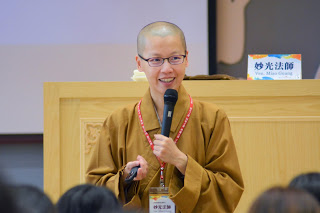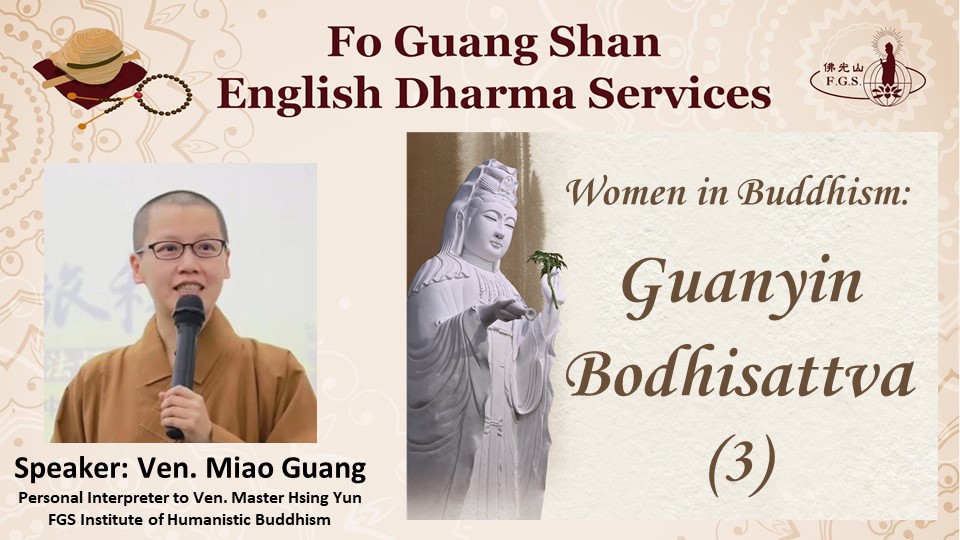
Speaker: Ven. Miao Guang
Personal Interpreter to Ven. Master Hsing Yun
Fo Guang Shan Institute of Humanistic Buddhism
I. Introduction
Auspicious greetings!
I hope you’ve had a fruitful week. May Buddhas and Bodhisattvas bless the world with courage and hope in the face of man-made calamity and natural disasters.
This week, we are going to continue the “Women in Buddhism” series on Guanyin Bodhisattva’s Powers. Last week, we walked through the Avalokitesvara Bodhisattva Universal Gate Chapter of the Lotus Sutra to look at the first type of Guanyin Power—a Wish Granter.
II. Remarks on the Previous Episode About the “Wish Grantor”
Before we continue to the next type of Guanyin Power, allow me to reiterate a few things about what had been said in the previous episode:
By “Wish Granting” we must realize a few things about Guanyin:
- She is acting out of great compassion to deliver sentient beings.
Maha Karuna—Great Compassion exceeds ordinary compassion because Guanyin regards all samsaric beings equally and upholds the vow to remove all forms of suffering because a bodhisattva of great compassion simply cannot bear to see anyone suffering. - Guanyin’s “guan” (observe) means her supernatural receptiveness to the sounds of suffering. This is more than just looking for or hearing with the sensory faculties but a spiritual connection established between Guanyin’s heart and sentient hearts.
- Having observed the sounds of cries, Guanyin is equipped with all kinds of abilities to cater to the needs of the beings. This too was due to Guanyin’s great vows.
For such reasons, Guanyin has always been viewed as the Great Being of Great Loving-Kindness, Great Compassion; one who responds extensively to all kinds of suffering and calamity. This is why she has the power of a wish grantor.
III. Guanyin’s Powers Continued (2): A Wise Liberator
The 2nd type of Guanyin Power is a Wise Liberator:
In order to receive Guanyin’s help, you too must also have faith in her awe-inspiring power as a Wise Liberator. By wise, it means her supreme and unparalleled wisdom to not only free you from suffering but in such articulate ways that you would feel she totally knows you, she gets you, and she is offering you a helping hand as your equal, so you feel comfortable and dignified as the rescued.
Once in Japan, a tunnel collapsed and trapped many people inside. An emergency doctor arrived and began to help those who were injured. Unfortunately, in the middle of his rescue work, the tunnel collapsed further and also trapped him under a huge block of concrete, fracturing his legs. A little boy nearby who was fortunately uninjured, witnessed the whole incident and began to cry out of shock and fear. The doctor, though trapped and severely injured, comforted the boy by telling him that light will protect him, and if he followed the light and kept running, all the fear and pain will be left behind in the dark. He then asked the little boy to take his only torch and keep running. Without thinking about himself, he managed to guide the boy away from danger. The doctor put himself in the place of the little boy and thought about what was best for him. In the end, rescuers found the boy and were able to follow his story to find the doctor.
To be able to offer universal liberation and regard all the beings Guanyin has saved as her equals, it takes not only great compassion, transcendental insight is also essential. Such transcendental insight is known in the Heart Sutra as prajna-paramita—the perfection of wisdom.
In the Heart Sutra, Avalokitesvara shares her experience of enlightenment by telling Sariputra,
As I was contemplating deep and profoundly the experience of prajnaparamita, what I suddenly realized was that the five skandhas were empty in nature, therefore, I overcame all ills and suffering.
Heart Sutra
As explained in my talk about the Heart Sutra, the five skandhas refer to the five aspects of human experience that we take to be the “self.” Very often we’d have the misconception that the self is the center of all experiences, that it is real. However, as much as it is not true, such a misconception leads to nothing but suffering in the end. Avalokitesvara’s further breakdown of this experience with the analysis of the six sensory roots—eye, ear, nose, tongue, body, and cognition, which when met with their respective objects—form, sound, smell, taste, touch, and things, becomes our conceptualized behaviors. All of these experiences are constantly varying and shifting. That’s why through the teaching of the five skandhas as empty, we become liberated from the trap of set behavioral patterns programmed by our previous experiences, thinking this would bring us happiness and peace. This is what is meant by “what we take to be our self, the seemingly real and dominant experience are like bubbles, flashes of light, a dream—all t delusions that we need not cling to.” There is no such thing. Just as we won’t grab onto empty space, we do not cling to non-substantial concepts. Happiness and peace are not found by attempting to make such experiences stay, but the ability to adapt to changes that are constantly happening to this experience yet still remain peaceful and at ease. Such contemplative realization (照見) is the perfection of wisdom.
Prajna wisdom keeps us in clear awareness, sublimates our sentiments, and elevates our spirituality to a supreme state that enables us to see life in a higher state of complete awareness and insight. When this happens, your view of the world becomes transcendental and you are no longer bound by partial views. You begin to sense your presence in this world with self-mastery where you are no longer led in the nose by your sensual experiences or the conceptualizing mind, both of which are eventually limited to the scope of suffering and cannot bring true bliss. Instead, you become empowered with the ability to overcome all types of suffering. The doctor in the collapsed tunnel shifted the focus away from himself and his fractured legs by dedicating his thoughts single-mindedly towards the wellbeing of the boy. Because of this selfless act, he too was saved by the rescuers who found the little boy, who in turn, told the rescuers about the doctor’s whereabouts. With a greater perspective on life, you embody an immense connection of conditions that can do wonders to both the self and others. The bigger your heart, the bigger your life.
The isvara in “Ava + lokita + isvara” refers to the insight that enables us to master our experiences of the self, that is why isvara is translated as “self-mastery.” Like a chef with mastery command not only in cooking skills but also how to elevate the flavors of raw ingredients so that the customer is given the best dining experience, self-mastery of human existence is to have master command in responding to each situation with awareness and calm rather than emotion and impulse.
Once a man and his 14-year-old son checked in at an airline counter for a flight across the country to visit grandpa and grandma. However, the entire check-in process was made extremely unpleasant by a grumpy and impatient ground staff. Not only did the staff not look the father in the eyes once, she even snatched their IDs from his hands to confirm information, and then rudely threw it onto the counter with the boarding passes, and waved beyond them for the next passenger without bidding them farewell. However, all along, the father continued to smile, looked at the staff in the eye to say thank you and goodbye. As they turned away, the son asked unhappily, “Dad, why be so nice to someone so impolite and rude?” The father replied, “She may have lost her manners, but this does not mean I have to throw mine away.”
The father knows who he is and what he should do without being influenced by other people’s negative emotions. This is self-mastery. Not only does self-mastery enable the insight of emptiness of the human experience, the same also goes with phenomenal experiences, spiritual experiences, the arising, ceasing, and cessation of suffering, the entire process of samsaric existence, and even the wisdom we attain are not something to cling to either.
Thus it can be said that in the Heart Sutra, we learn from Avalokitesvara a comprehensive understanding of reality in the following aspects:
- The process of existence
- How existence is experienced
- How existence evolves
- The truth about such existence
- Finding the path to liberation to be free from the trap of existence
- Being liberated ultimately
In other words, through the profound contemplative realization, Avalokitesvara demonstrates mastery command in the skills of observing and understanding the different aspects of existence on a transcendental level, thereby liberating us from all forms of ignorance. From this point onwards, our perspective of life is no longer the same. It is higher, broader, wide, much more free and insightful, and entirely transformed.
In such texts as the Heart Sutra, the Shurangama Sutra, and the Avatamsaka Sutra, practitioners are directed towards the ultimate goal of attaining enlightenment through cultivating the perfection of wisdom. Thus finding the ultimate solution to life and death is just the same. We see in the pursuit of buddhahood the manifestation of prajna wisdom. Only with firm belief in the possibility of enlightenment will liberation become a possibility for you.
Guanyin so happens to have the power to help us do so, it is the power of a wise liberator.
IV. Guanyin’s Powers Continued (3): A Beacon of Pure Land
The third type of Guanyin Power is to be a Beacon of Pure Land.
The most popular Pure Land faith is certainly Amitabha Buddha’s Western Land of Ultimate Bliss. Guanyin comes into the picture in the Amitāyurdhyāna Sūtra (觀無量壽佛經) as part of the Western Pure Land Trinity. The sutra tells the story about Prince Ajatasatru who, under Devadatta’s wicked influence, imprisoned his father, King Bimbisara and deprived him of water and food. In order to save the king, Queen Vaidehi, having purified herself by bathing and washing, anointed her body with honey and ghee mixed with corn-flour, and concealed the juice of grapes in the garlands she wore in order to give him food without being noticed by the guards. As she stole in and made an offering to him, he was able to regain energy and then turned towards Vulture Peak with joined palms and prayed to the World-Honored One for his compassion and guidance. On this, the Buddha sent Mahamaudgalyayana and Purna in turn to the king to teach him the eight precepts and the Dharma. The king thereby felt peace and was free from any resentment in his rebellious son.
Having found out that the Queen had secretly helped his father, Ajatasatru was furious and locked the Queen up in a cell. Vaidehi too, prays to Buddha for help, and he was able to visit her in supernatural manifestation. Vaidehi expresses her wish to be born in Amitābha’s Pure Land. The Buddha smiled, emitting light from his mouth, and went on to tell Vaidehi how to be reborn in the Pure Land. The Buddha told her that although she was in prison, she could still obtain liberation through the practices of Amitābha. The Buddha went on to describe Amitābha and how one could obtain rebirth in his land of Sukhavati. As the story goes on, this is how Avalokitesvara comes into the picture:
Amitabha Buddha stood in the midst of the sky with Bodhisattvas Mahasthama and Avalokitesvara, attending on his right and left respectively. There was such a bright and dazzling radiance that no one could see clearly; the brilliance was a hundred thousand times greater than that of gold.Thereupon Vaidehi saw Amitabha Buddha and approached the World-Honored One, and made obeisance to him, touching his feet, and spoke to him as follows: ‘Exalted One! I am now able, by the power of Buddha, to see Amitabha Buddha together with the two Bodhisattvas. But how shall all the beings of the future meditate on Amitabha Buddha and the two Bodhisattvas?’
Amitāyurdhyāna Sūtra
The Buddha went on to teach Vaidehi and Ananda how to meditate on the Buddha and two Bodhisattvas who were considered excellent friends of Amitabha, thereby fulfilling Vaidehi’s wish to be reborn in Pure Land. She was filled with boundless joy.
Chinese Buddhists refer to the Avalokitesvara here as the Guiding Bodhisattva who appears in front of the deceased with a silky banner in her hand. You can see how Guanyin in this case turns backward towards whoever she is guiding to make sure the consciousness of the deceased does not get lost. Thus the 3rd type of Guanyin Power is her power to become a Beacon of Western Pure Land.
Again, whoever receives the guidance must have faith in (1) Amitabha Buddha, (2) his vow that anyone who calls upon his name with single-minded effort for one, two….up to seven consecutive days will be guided to his Western Pure Land, and (3) Guanyin’s vow to assist Amitabha in delivering sentient beings by guiding them. We can regard this as the process of migrating to another world.
Some may wonder, why would Guanyin come to you when you have dedicated your whole body and mind to reciting Amitabha Buddha? As the saying goes, “Each and every buddha tread on the same path, and rays of lights never obstruct each other’s brightness.” What matters is not whose name you are chanting, the most important is your unwavering faith in the Pure Land as well as your willingness to practice this single-minded effort. Next question, if Guanyin is already so powerful herself, why does she need to become Amitabha Buddha’s assistant? In the Great Compassion Dharani Sutra, Avalokitesvara officially declares Amitabha as her teacher. The story goes as follows:
Eons before Avalokitesvara attained buddhahood, she was still cultivating as a human being who made a vow to deliver all living beings. She declared, “Shall I fail to accomplish the vow, let my body shatter into a thousand pieces.” However, things are always easier said than done. Living beings are way too ignorant and stubborn than she could imagine, let alone the countless number of such beings. As she caved in and contemplated giving up, she began to experience excruciating pain in her entire body, which split into thousands of pieces. At that moment, Amitabha Buddha appeared before her, touched her head, and comforted her by telling her not to be afraid, never regress on her bodhicitta, and that as long as she continued to strive on, her vows will come true. All of a sudden, Amitabha’s supernatural power turned the shattered pieces of her body into many heads as well as a thousand hands and a thousand eyes. Avalokitesvara was thus immensely empowered to accomplish her great vows. Out of gratitude, Avalokitesvara thus reveres Amitabha as her teacher and vows to assist Amitabha in delivering sentient beings. That is why atop the head of four-faced or eleven-faced Guanyin statues, you’d always see an image of Amitabha, the teacher of Avalokitesvara. It is also said that Avalokitesvara will succeed Amitabha as the next master of the Western Pure Land.
A beacon is a light of hope in the dark, a sense of direction when you are lost. Yet Guanyin as a selfless beacon is willing to just remain a part of the process, a guide on the path to liberation. Guanyin is aware that she is not the goal, not the master of anyone. The perfect willingness to walk alongside us through the dark patches of life is tremendous. Only truly compassionate and selfless hearts can do that for people. May we also become the beacon of bliss for our family, friends, and world.
V. Conclusion
It’s time to stop again, next week, we shall cover 3 more types of Guanyin Power—Guanyin as an empowerer, an encourager of good and meritorious deeds, a spiritual life coach. Thank you for watching. May Guanyin’s compassion and wisdom bless you with peace and tranquility. See you next week.

